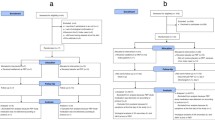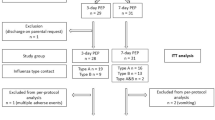Samenvatting
Wanneer een gezinslid een bewezen influenza-infectie heeft, ligt het percentage gezinsleden dat eveneens een influenza-infectie oploopt tussen de 10 en 40% (1). Twee studies beschrijven het beschermend effect van oseltamivirprofylaxe ten opzichte van placebo binnen gezinnen met een bevestigde influenza-casus (1,2). In de studies daalde het percentage secundair geïnfecteerde gezinsleden van 26 en 23% (placebo) naar 11 en 3,6% (oseltamivir-PEP gezinsleden) Dit betekent dat oseltamivir een beschermend effect heeft van respectievelijk 59 en 84% (1,2). Gedurende een influenza epidemie zal een deel van de populatie besmettelijk zijn. Het effect van gezinsprofylaxe neemt af bij een toename van virale transmissie tussen gezinsleden en de populatie. Het is duidelijk dat de duur van 10 dagen oseltamivir-PEP niet afdoende is om beschermd te zijn tegen infectie gedurende een mogelijk maanden aanhoudende influenza-epidemie.
arts infectieziektebestrijding i.o. GGD Midden-Nederland, Zeist
arts viroloog, Universitair Medisch Centrum, Utrecht.
Similar content being viewed by others
Referenties
Hayden FG, Belshe R, Villanueva C, et al. Management of influenza in households: a prospective, randomized comparison of oseltamivir treatment with or without postexposure prophylaxis. J Infect Dis 2004; 189: 440-49.
Welliver R, Monto AS, Carewicz O, et al. Effectiveness of oseltamivir in preventing influenza in household contacts. A randomized controlled trial. JAMA 2001; 285: 748-54.
Farmacotherapeutisch kompas. Houten: Bohn Stafleu van Loghum, 2006.
Jefferson TO, Demicheli V, Rivetti D, et al. Antivirals for influenza in healthy adults: systemic review. Lancet 2006; 367: 303-13.
Kiso M, Mitamura K, Sakai-Tagaw Y, et al. Resistant influenza A viruses in children treated with oseltamivir: descriptive study. Lancet 2004; 364: 759-65.
Koopmans M, Wilbrink B, Conyn M, et al. Transmission of H7N7 avian influenza A virus to human beings during a large outbreak in commercial poultry farms in the Netherlands. Lancet 2004; 363: 587-93.
Jefferson TO, Demicheli V, Rivetti D, et al. Neuraminidase inhibitors for preventing and treating influenza in healthy adults (review). Cochrane Database Syst Rev 2006 Jul 19; 3: CD001265. Review.
Sander B, Hayden FG, Gyldmark M, Garrison LP jr. Post-exposure influenza prophylaxis with oseltamivir: cost effectiveness and cost utility in families in the UK. Pharmacoeconomics 2006; 24: 373-86.
Author information
Authors and Affiliations
Copyright information
© 2006 Bohn Stafleu van Loghum
About this chapter
Cite this chapter
Fanoy, E., Boucher, C. (2006). Is het zinvol oseltamivir te adviseren als postexpositie profylaxe (PEP) wanneer een gezinslid thuis een influenza-infectie doormaakt?. In: Vademecum permanente nascholing huisartsen. Bohn Stafleu van Loghum, Houten. https://doi.org/10.1007/978-90-313-8808-0_862
Download citation
DOI: https://doi.org/10.1007/978-90-313-8808-0_862
Publisher Name: Bohn Stafleu van Loghum, Houten
Print ISBN: 978-90-313-8807-3
Online ISBN: 978-90-313-8808-0
eBook Packages: Dutch language eBook collection




